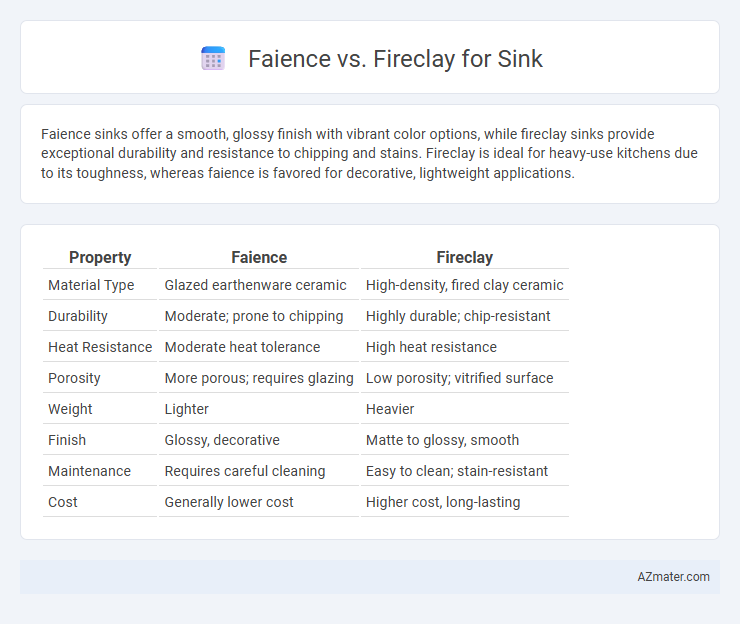Faience sinks offer a smooth, glossy finish with vibrant color options, while fireclay sinks provide exceptional durability and resistance to chipping and stains. Fireclay is ideal for heavy-use kitchens due to its toughness, whereas faience is favored for decorative, lightweight applications.
Table of Comparison
| Property | Faience | Fireclay |
|---|---|---|
| Material Type | Glazed earthenware ceramic | High-density, fired clay ceramic |
| Durability | Moderate; prone to chipping | Highly durable; chip-resistant |
| Heat Resistance | Moderate heat tolerance | High heat resistance |
| Porosity | More porous; requires glazing | Low porosity; vitrified surface |
| Weight | Lighter | Heavier |
| Finish | Glossy, decorative | Matte to glossy, smooth |
| Maintenance | Requires careful cleaning | Easy to clean; stain-resistant |
| Cost | Generally lower cost | Higher cost, long-lasting |
Introduction to Faience and Fireclay Sinks
Faience sinks, crafted from glazed ceramic with a smooth, glossy finish, offer a classic aesthetic and are resistant to stains and scratches. Fireclay sinks are made from molded clay fired at extremely high temperatures, resulting in a durable, non-porous surface that withstands heavy use and resists chipping. Both materials provide timeless appeal, but faience excels in decorative glazing options, while fireclay is prized for its robustness and ease of maintenance in kitchen and bathroom settings.
Composition and Manufacturing Differences
Faience sinks are crafted from a type of glazed ceramic composed mainly of fine clay combined with quartz and feldspar, resulting in a smooth, glossy surface achieved through a high-temperature kiln firing process. Fireclay sinks, on the other hand, are made from a dense, vitrified clay mixture fired at even higher temperatures, which creates an ultra-hard, non-porous surface resistant to chipping and staining. The manufacturing difference lies in fireclay's longer firing cycle and higher heat tolerance compared to faience, making fireclay sinks more durable and suitable for heavy-duty kitchen use.
Durability and Strength Comparison
Fireclay sinks exhibit superior durability and strength compared to faience sinks due to their dense, vitrified composition that resists chipping and cracking under heavy use. Faience, a glazed ceramic material, tends to be more prone to surface scratches and less resilient to impact, making it less ideal for high-traffic kitchen environments. Fireclay's ability to withstand high temperatures and maintain structural integrity over time solidifies its position as the more robust sink material.
Aesthetics and Design Options
Faience sinks offer intricate, hand-painted designs and vibrant colors that bring a distinctive, artisanal aesthetic to kitchens and bathrooms. Fireclay sinks provide a smooth, glossy finish with a timeless, classic appeal available in various shapes and sizes to complement traditional and modern decor. Both materials support versatile design options, but faience excels in ornamental detail while fireclay emphasizes durability with refined simplicity.
Resistance to Staining and Scratching
Fireclay sinks exhibit exceptional resistance to staining and scratching due to their dense composition and high firing temperatures, making them durable and easy to maintain in busy kitchens. Faience sinks, while aesthetically pleasing with glazed surfaces, tend to be more porous and softer, resulting in higher susceptibility to stains and surface scratches over time. Choosing fireclay ensures long-lasting durability and maintains a pristine appearance under frequent use, especially in demanding environments.
Maintenance and Cleaning Requirements
Faience sinks require gentle cleaning with non-abrasive, pH-neutral cleaners to prevent surface damage and preserve their glossy finish, while fireclay sinks boast exceptional durability and stain resistance, allowing for easier maintenance with common household cleaners. Fireclay's dense, vitrified surface resists scratches, chips, and discoloration, making it ideal for busy kitchens needing frequent cleaning. Faience demands more cautious care to avoid etching and loss of shine, whereas fireclay offers a low-maintenance option with long-term resilience.
Cost and Long-Term Value
Faience sinks typically have a lower upfront cost compared to fireclay sinks, making them more budget-friendly for initial installation. Fireclay sinks, while more expensive, offer superior durability and resistance to chipping and staining, resulting in enhanced long-term value. Investing in fireclay can reduce replacement and maintenance expenses over time, providing better return on investment despite the higher initial price.
Environmental Impact and Sustainability
Faience sinks, made from glazed earthenware, have a lower environmental footprint due to their use of natural clay materials and energy-efficient firing processes, contributing to reduced CO2 emissions. Fireclay sinks, constructed from refined clay and feldspar, require higher firing temperatures, resulting in greater energy consumption and environmental impact during production. Both materials offer durability and longevity, supporting sustainability by minimizing the need for frequent replacements in kitchen or bathroom installations.
Suitability for Kitchen and Bathroom Use
Faience sinks offer vibrant, glazed surfaces that resist stains and are ideal for decorative bathroom use, yet their delicate nature makes them prone to chipping in high-traffic areas. Fireclay sinks, crafted from molded ceramic clay fired at high temperatures, provide exceptional durability, heat resistance, and non-porous surfaces suitable for rigorous kitchen environments. Both materials excel in moisture resistance, but fireclay's robustness and ability to withstand heavy impacts make it the preferred choice for busy kitchens, while faience suits aesthetic-focused bathrooms.
Choosing Between Faience and Fireclay Sinks
Selecting between faience and fireclay sinks depends on durability and aesthetic preferences; fireclay sinks offer superior resistance to chipping and heat due to their high-temperature firing process, making them ideal for heavy kitchen use. Faience sinks, crafted from tin-glazed earthenware, provide vibrant color options and intricate designs but are more prone to scratching and staining. Assessing the kitchen environment and maintenance willingness helps determine the best choice for long-lasting functionality and style.

Infographic: Faience vs Fireclay for Sink
 azmater.com
azmater.com